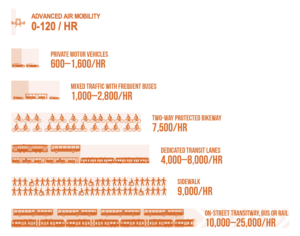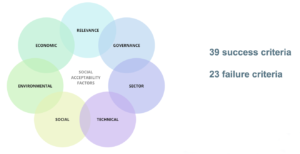Guest Contributor Catherine Roy, Design Center Quebec Leader, Design Center Network Community Leader

Catherine Roy is a design leader at Thales Design Center Quebec, the design studio that covers North America. On a global scale, Catherine leads the community of Thales’ 14 Design Centers around the world to make strategic foresight and design shine and grow. She is a practitioner of strategic foresight to create breaking future visions of what things could be, strategies, and innovations.

The Advanced Air Mobility industry will face many challenges on all fronts for its implementation, many of which the industry is preparing. AI picture by Artssy
Flying cars, air taxis… The image has been around us for a long time. Taking off from point A, getting to point B, escaping gravity like a Jetson, is the apotheosis of technological refinement for many in the aerospace industry. The technology is already here. But how will society welcome this new form of mobility?
Advanced Air Mobility… what is it?
The Advanced Air Mobility (AAM) is an umbrella term for aircrafts that are highly automated and electric. The AAM refers to an automated air transportation system for passengers and cargo in urban and rural locations. Mostly autonomous, they fly without a human controlling it. These small aircrafts are called eVOLs (electric vertical take-off and landing) They are often referred to as air taxis. They usually have 3 or 4 passengers. Many demonstrations are taking place around the world.
Everything is to be built: the aircrafts, the energy system, the communication systems, the infrastructure, the vertiports. It means also to change the law, as the new mobility mode operates in different airspaces than traditional airlines.
What does it mean socially, environmentally, economically, and politically for the AAM, a highly technological industry trying to implement itself?
A major Foresight Study sponsored by the CRIAQ
I was fortunate to collaborate with the CRIAQ, The Consortium for Research and Innovation in Aerospace in Québec, a non-profit organization to increase the competitiveness of Quebec’s aerospace sector by stimulating technological innovation, collaborative research and development.
We built a foresight project to identify critical social, environmental, political, and economic enabling conditions and criteria for the social acceptability of a sustainable and integrated Advanced Air Mobility system (AAM) over a 15-year horizon (2038). We counted on the University of Houston’s Framework Foresight to structure our methodology. The project relied on a team of 16 experts from fields beyond aerospace, many recognized and distinguished university professors.
51 implications, 7 factors of social acceptability, and 62 success and failure criteria
Nearly 300 documentary sources were analyzed, including meta studies. We identified 51 findings and implications, and 7 factors of social acceptability for the industry wishing to establish itself in Quebec, Canada. The 7 factors of social acceptability: economic, technical, social and environmental, relevance, governance and the sector are broken down into 39 success criteria and 23 failure criteria. For the first time, criteria expand the traditional notions of safety, security and noise. For example, for relevance : a success criteria would be a real response to a societal problem that has been validated and integrated into a mobility vision of mobility; a failure criteria would be competitiveness with existing modes of transportation. More, criteria are new and provocative, not a ranking of the pre-established aerospace industry’s favorites.
Challenges in an uncertain world
Environmental crises and energy
In 2038, the AAM industry will face major challenges on all fronts for its implementation. Extreme storms and changing weather have the potential to create unfavorable conditions to insure a reliable service and a resilient business model. This means flying in low-altitude urban areas could become hazardous, many service interruptions depending on the season could happen, and therefore alternative solutions need to be considered if flights are delayed, cancelled, and/or rerouted. This is a major hurdle for the industry for which its value proposition is based on convenience and time savings compared to other mobility.
The electrification of all transportation modes poses a challenge in terms of energy, network and availability of minerals supporting growth. The AAM is no different, and adds a new need that was not previously factored in. All signals point to the inability to produce the energy required for electrification.
- By 2031-2032, electric vehicles are expected to require nearly 1,800 MW for peak charging. This new use will clearly pose a significant challenge for network management.
- Hydro Quebec’s 2023-2032 Supply Plan confirms that surpluses will be exhausted after 2026 and announces needs of more than 100 TWh by 2050, to achieve net-zero emissions.
Government response
The environmental crises, energy crisis and the aging demographics, among others, will pose a challenge to position the AAM on the chessboard of policy issue priorities of the various levels of government in place. A greater pressure will be put on allocating governments’ financial resources to meet the basic needs of the population first: pensions, health, consequences of environmental crises, and immigration. The space for private-public bargaining will be very tight. Financing AAM might not be at the top of the government’s priorities.
Integrating AAM into the urban fabric and mobility mix
The AAM needs integrating into an existing built environment that requires adaptation to new uses and the creation of new urban, territorial, environmental and air regulatory frameworks. These steps will be costly and complex. In addition, the AAM will have to integrate into the existing mobility mix and will have to demonstrate a response to travel needs that are not met by the options currently available. The universality and inclusiveness of the AAM are yet to be demonstrated, as well as the capacity requirements that are currently negligible.
Our calculations point to a capacity of 0-120 people per hour in Montreal for AAM, compared to a capacity of 10,000 – 25,000 people per hour for on-street transitway, bus or rail. How many VTOLs would it take to reach the load capacity of a single highway lane? 1,246 VTOLs in the air at the same time[1]. This is unlikely.

National Association of City Transportation Officials https://nacto.org/publication/transit-street-design-guide/introduction/why/designing-move-people/
Beyond the celebrity of the promoters and the hype, any system needs to be properly evaluated, appraised, analyzed and assessed. Any new urban transport system must be practical, sensible, safe, and supported by people who use it widely or it will fail.
8 Recommendations
We proposed 8 recommendations for the industry to initiate the process of integrating social acceptability criteria: validate the maturity and efficiency of the technology; conduct comprehensive and detailed studies and analysis; identify the required authorizations; create a realistic, accessible and universal user experience; ensure the implementation of the AAM in other settings and prepare contingency plans; establish a multi-stakeholder committee for an integrated roadmap for socially acceptable development of the AAM; introduce AAM to government bodies; and finally continue to evaluate the criteria of social acceptability. Finally, we created a social acceptability maturity scale of the AAM, a social risk analysis tool, and a project evaluation grid. These tools are necessary for a more sensible, concerted, inclusive, and acceptable new industry taking off.






